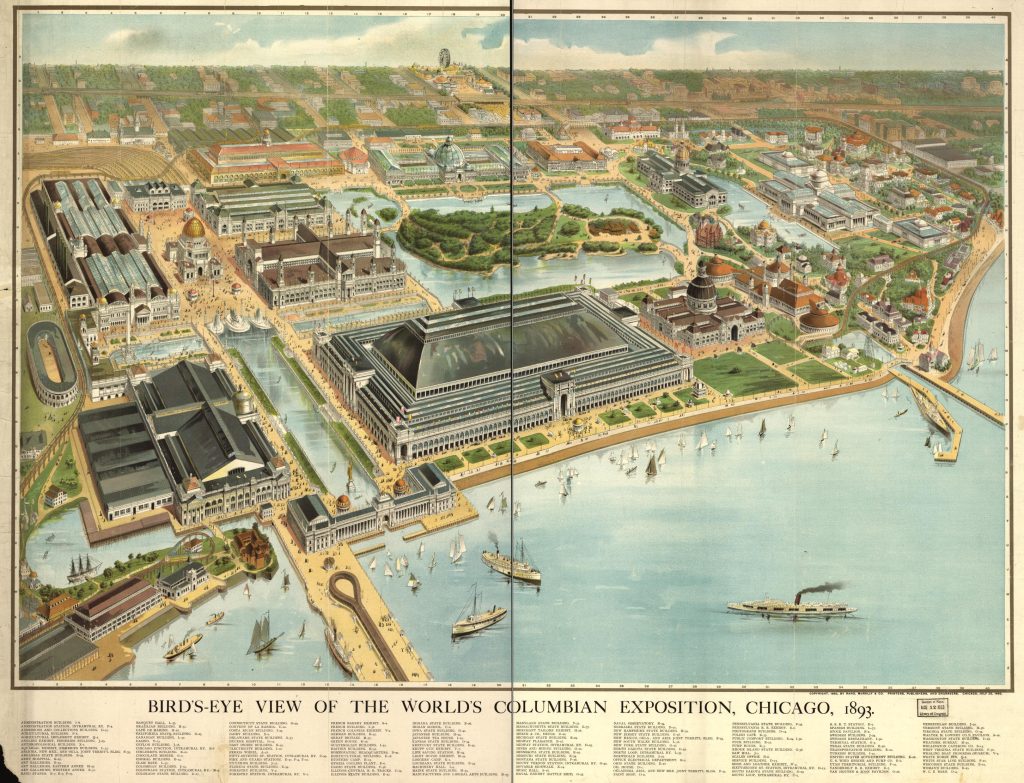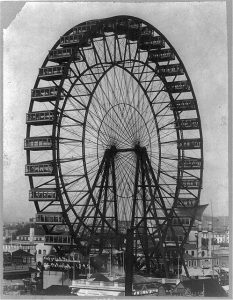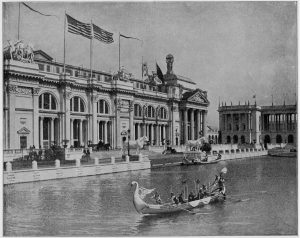Corridor Connections to the 1893 World’s Fair
Written by Cyan Fink, DLNHC Inventory Coordinator

Map of the 1893 World’s Fair. The north and south canals can be seen middle left side of the map.
Before we had the internet and could share our thoughts in seconds, people had to be creative when trying to show off new inventions and ideas. This need brought about the World’s Fair with the idea that the event would be a time when people from around the world could get together and share cultures, ideas, and inventions with one another.
The first official World’s Fair in America was held in Philadelphia in 1876 to celebrate the centennial of the United States. America would go on to be the host for a few more fairs, including one of the most famous (or infamous) fairs – the 1893 Chicago World’s Fair. Also known as the World’s Columbian Exposition, this fair featured the Ferris Wheel, brownies, and Josephine Garis Cochran’s invention, the dishwasher. Unfortunately, this Fair is also featured tragedy from fires and the assassination of the Chicago Mayor, Carter Harrison. And to some, the Fair is best known by the evil deeds of America’s first known serial killer – H. H. Holmes.

Designed by Pittsburgh engineer, George Washington Gale Ferris Jr., the “Chicago Wheel” is pictured here during the fair. It was 264 feet tall and took the 36 gondolas on 10 to 20-minute rides, which visitors paid $.50 to enjoy. The Bethlehem Iron Company produced the axle.
Even though this Fair was far from the Delaware & Lehigh National Heritage Corridor, there were few local connections. If you have ever heard Chicago called the White City that would be due to the way the Fair’s buildings were constructed. The Fair featured nearly 200 temporary neoclassical style buildings which were not meant to last longer than the Fair. They were built cheaply and then painted to look like shiny white marble. To accomplish this task in a short period of time, the builders used spray-paint, which made their tedious task faster. The invention of the spray-paint eventually led Chicagoan Carl Akeley and later Allentonian Samuel W. Traylor to invent the Cement Gun. If you would like to learn more about this invention, check out the book, From Elephants to Swimming Pools by Louis Rodriquez (for sale in the DLNHC online store: From Elephants to Swimming Pools – National Canal Museum).
In addition to the breath-taking buildings, the fair also featured the first Ferris Wheel created by George Washington Gale Ferris, Jr. The Chicago Wheel was one of the largest and best-known attractions of the Fair due to its sheer size. In order to “one-up” Paris’ 1889 Exposition which saw the unveiling of the Eiffel Tower, the Wheel was 263 feet tall and had 36 gondolas which could hold over 1,000 people at one time! The Wheel was powered by a 71-ton 45.5-foot-long axle, manufactured by the Bethlehem Iron Company, and was said to have been the largest piece ever created at that time.
While the Ferris Wheel was just one of the awe-inspiring creations across the 690-acre Fair, visitors could not miss the multiple water features. Water played an important part in the White City, as Jackson Park sat right on the edge of Lake Michigan. Frederick Law Olmsted, the landscape architect of the Fair, used canals, pools, and lagoons to create islands to help split up the nearly 200 buildings of the Fair. Intersected by the basin which connected the park to Lake Michigan, the North and South Canals ran along the lengths of the Electricity Building, Manufactures and Liberal Arts Building, Agriculture Building, the Machinery Annex Building, and the Administration Building. Floating on the canals were Venetian swan gondolas, which allowed visitors to take a romantic boat ride along the waterways while taking in the sites and crowds.

A swan gondola floats on the canal with the Agricultural Building in the background.
However, the canals built within Jackson Park were not the only canals which helped the World’s Fair. Newspaper articles from the time proclaim about an uptick in canal usage throughout the eastern United States. One article states that the canals were doing, “Better than the Last 14 Seasons, [and] the Canal-men say World’s Fair Traffic Gave the Canal a Show.” This increase in traffic can be attributed to the busy schedule of trains taking materials, and later passengers, to Chicago. With the trains out of commission, the canals once again became the best option for moving goods. Even some tourists decided to use the canals. An article from The News in New York announced that the Salmagundi Men Smoke Club would take a stagecoach from Albany where they would then take the Erie Canal as part of their journey to the Fair.
Sadly, for the leaders of the Chicago’s World’s Fair, the Fair was not as prosperous as they would have hoped, and it was marred by tragedy including the assassination of the Mayor two days before the Fair closed. The closing events quickly turned into a memorial service as the city mourned. Soon after, most buildings were taken down and the grounds transformed into Jackson Park. The “Chicago Wheel” was moved to North Clark Street until 1903 when it was sold and rebuilt for the 1904 World’s Fair in St. Louis. Sadly, it was demolished and sold for scrap in 1906. No one is sure what happened to the Bethlehem Iron Company’s axel. Only two buildings still exist, The Palace of Fine Arts and the Word’s Congress Auxiliary Building, which are now both museums. As for the water features of the Fair, only the lagoon and pond still exist, as the once-stunning basin and canals were transformed into a harbor to hold boats for use on Lake Michigan.
**Brought to you by a project made possible in part by the Museums for America grant from the Institute of Museum and Library Services. The views, findings, conclusions, or recommendations expressed in this post do not necessarily represent those of the Institute of Museum and Library Services.**























Join the Conversation!